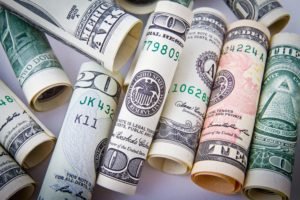
They say money is what money does. Believe me, it actually is so. How else would there be something without an intrinsic value that values everything? Money could be a piece of metal, nowadays a cheap one or widely available, or a piece of paper.
Then what makes it so valuable, you must be wondering. It is only our “faith” that it will buy us everything we need to buy. The faith on the promise that it propagates; for example a 50 RS note says, “I promise to pay the bearer the sum of fifty rupees” and so do the other notes. All these promissory notes are signed by the incumbent governor of the central bank and guaranteed by the same institution of the particular country.
Take a movement and imagine if someone doesn’t believe in it; someone just questions the promise and asks the said authority to show her the proof. What will the central bank or the state, which gives the central bank the authority to promise such a thing, do?
However, no one questions it at all. I wonder if anyone has noticed even the promise written on it. In the course of time, we have forgotten that it is just a promissory note.
In earlier times, people would write down the number of things someone took from them on a clay tablet. After the debtor returned the things, they would break the tablet. There are some unreliable stories about the barter system but that would need double coincidence of wants to make a transaction, between the two parties, happen. Some scholars say that barter never took place at a massive scale.
During and after the Iron Age, however, metals replaced the tablets. After the metal extraction gained pace, the money became susceptible to forgery. In the later period, gold and silver, and other ornamental metals, became the tool of transaction in the market. Remember, the lesser the availability of something the greater the value of that thing.
When the markets expanded and population exploded, there was little gold left for the transactions. However, there was one thing common in all the metallic standards of money: all the metals had face value.
Exports would rarely take place as every society was self-sufficient and people were hardly interested in the outside world. But when they did, metals and tools were always preferred as a source of exchange primarily due to its portability and universal value.
What Does Money Do?
The six characteristics of money are durability, portability, acceptability, limited supply, divisibility and uniformity.
Durability: it means that money bills or coins withstand repeated use and are easily replaceable if they become damaged.
Portability: it means that money can easily be carried and transported from one location to the next.
Acceptability: means that money is commonly accepted as a value of payment.
Limited Supply: It ensures that money holds its value.
Divisibility: it suggests that money can be broken down into smaller values.
Uniformity: it creates a standard for the look of various denominations. The value of money should not fluctuate.
Money Has Three Basic Functions
It is a medium of exchange: the most significant function of the money is to serve as medium of payment. For that to happen, money must be accepted by people in exchange of goods and services.
It is a measure of value: money serves as a common denominator of value. In other words, with the help of this function, all the goods and services are measured and expressed in monetary terms. Here, money gives language to the economic communications.
A store of value: since money is a unit of value and a generally acceptable means of payment, it acts as a store of value as it is so easy to spend and so easy to store, owing to its durability and portability characteristics.
Paper Money and Its Working

It is believed that even cows were used as a means of payment in the earlier times. Like in modern prisons, cigarettes are used as a means of payment.
However, when the legal authorities started writing down the transactions and these written promissory notes became transferable in no time. The traces of such promissory notes, mostly written on leather and parchment, could be found in China that appeared during Han Dynasty in 118 BC and in Rome where the lightweight substance was used as legal tender in CE 57.
But these checks were backed by a promise that the signee will provide the same worth of gold to the bearer of the check. China was the first country to introduce the paper money in CE 618 to 907 during Tang dynasty. It was reinstated by Song dynasty from 11th century onwards. Consequently, the banks were formed but the King’s court would operate and monitor all the transactions.
During the renaissance period, Monte Di Pieta, a charity organization, became the origin of modern banking system in 1472. In its current form, its name was changed to Banca Monte Dei Paschi Di Siena in 1624. Banks started giving checks or a piece of paper with a promise that these checks are liquidated in gold. In 1668, first central bank was born in Sweden namely Sveriges Riksbank.
What computers are for modern technology paper money is for economy. In the Gold standard economies, at least in their earlier stage, one could replace the promissory note with gold in any nearest bank that had authorized it. However, that faded after a while and banks kept in store the amount of gold that was worth the amount of money they had circulated.
After the great depression, the economies started to shun the standard in the early 20th century. After that, the paper standard became the norm that only kept, and still keeps, some percentage of gold in the central bank against the money in the market.
Great depression began in United States in 1930s after a drastic fall in stock prices that took place around September 4, 1929. But the world came to know about it only on 29th October 1929 when the news broke out in international newspapers. That day is known as Black Tuesday.
Also, we cannot rule out the velocity of the circulation of checks and paper money which in itself is the creation of money. Do you wonder how? See, we don’t write all our transactions that we carry out with our friends and relatives. There is a silent promise involved in every debt that says that the debtor will pay back the money to the creditor. That silent promise becomes the medium of exchange.
Also, that person may give it to other person and receive a promise that she will pay her back, and that person will give it to someone else and so on and so forth. The more the money changes hands, the more money is created; and the speed at which the money changes hands is called the velocity of money.
Astonishingly, no part of the paper money circulated in the market could be liquidated in gold in the current epoch. It is only our faith in the paper money that has made it too strong to be questioned.

